Mandanities Vol. 3, Making Charcoal
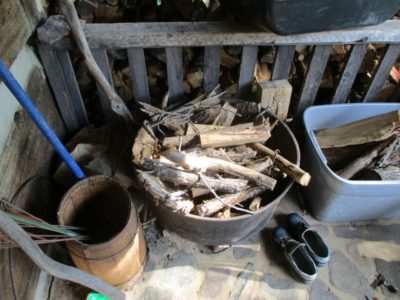
One of the things about living on the edge of the forest, especially if you are trying to carve out more space along the edge, is that you have to deal with a lot of wood and brush. Bigger trees are not a strategic problem, they get cut, split, and stacked as firewood. For branches smaller than wrist-sized it is a judgment call, are they firewood or are they kindling? For the most part in recent years the primary use was as kindling as Mrs. Barn, normally the fire tender as she gets up earlier than I do, would fill the giant cauldron on the front porch with sticks to serve that function throughout the winter.
The simplest way to deal with excess brush and branches is to just throw them back further into the frontier at the edge of the forest, a “solution” that bites you when eventually pushing that frontier back as we are doing right now. For the most part the ultimate solution is to either get a chipper or burn up the inventory in a burn pit or barrel.
Recently Mrs. Barn came up with brilliant idea — turn the excess into charcoal. This plan may or may not have coincided with her exploration of the Weber grill as a smoker/outdoor oven/broiler to keep heat out of the kitchen when it gets hot here (in the 80s). She has been experimenting with great success in that realm. Combined with my own interest in charcoal-making it seemed like this was the time to begin skipping down that path.
I hired a local fellow to do a ton of weed eating around the homestead, and one of the things that venture revealed was the number and size of brush piles we had underneath the greenery. So, I’ve been slowly pulling out the brush and clearing the path to the felled firwood trees out behind the log barn. Since it was going to be burned up anyway, why not try to turn some of it into charcoal?
I’d attended a charcoal-making workshop many years ago and remembered that the “controlled ignition” system while more efficient was also much trickier; you gotta get the burn conditions just right to cause the raw material to smolder until it was fully carbonized and no farther. The “retort” system — essentially cooking the wood down to its basic carbon form — though less efficient, struck me as much simpler and easier. So, I dug out a heavyweight small trash can, took it to the burn barrel, and gave it a try. With great success!
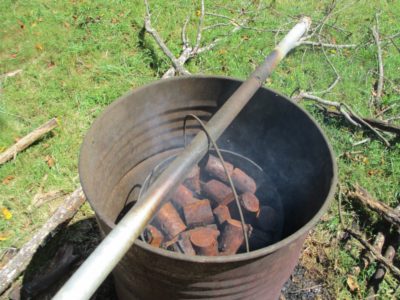
Actually the first step was to select a few wrist-sized branches and haul them up to the barn and cut them into 3″ pieces on the chop saw. When the small trash can was full it was time to head down to the burn barrel and give it a try.
I built about a six-inch bed of twigs at the bottom of the burn barrel and lit that, letting it burn and adding fuel until I had a hot fire. Then I lifted the small trash can into the barrel and sat it on the bottom fire. This was not particularly easy as the contents of the trash can had not been seasoned in any meaningful way, they had just been a pile of brush in the tall grass. The can was really heavy.

One I had the trash can situated in the barrel I fed a large galvanized pipe through the handle so that the trash can would hang once the bottom fire burned down. I did not know if this was a useful approach but it seemed like a smart way to even out the heat through the charcoal can. I then selected a large number of smaller branches, 1″ – 2″, and hand cut them into 6-inch pieces which I then fed into the barrel all around the outside of the charcoal can, filling up the barrel to the lid of the charcoal can. I laid a handful of 2-inch sticks on top of the trash can and waited to see what happened.

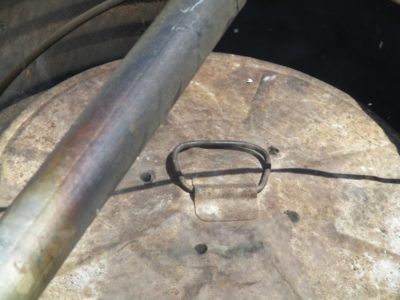
As expected, soon enough there was a plume of steam coming out of the four holes I had pre-drilled into the lid of the trash can, as first the unbound water and then the bound water was distilled out of the wood. This process took about three or four hours. All I had to do was stand there and watch.
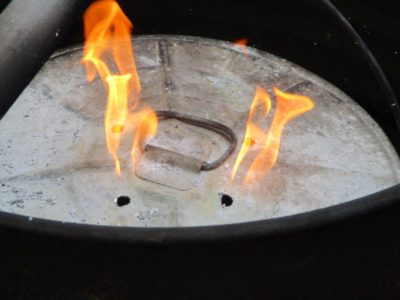
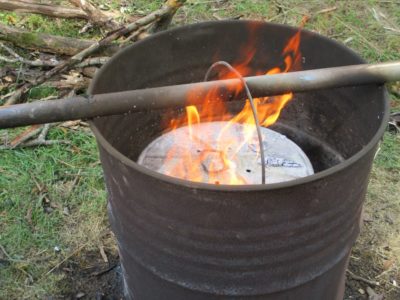
The real excitement occurred at about the 4-5 hour mark as the moisture was all gone — the presence of the moisture had regulated the internal temperature to 212 degrees (remember 9th grade Physical Science?) — and the temperature inside the trash can jumped to the point where formaldehyde and methanol were being distilled off from the carbonizing wood. Quick as a flash I had jets of flame whooshing out of the holes in the lid and from around the rim where the lid fit the trash can. For almost an hour the flames did their job, then they were gone.
After that I let the entire barrel-and-trash-can stay undisturbed while any remaining fuel burned off and the whole thing cooled down over night.
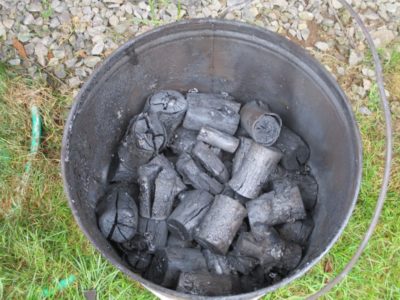
In the morning I could hardly wait to see what I had wrought. The results were spectacularly successful, beautiful charcoal just waiting to be put to use on the grill. The end product was 1/3 smaller and 3/4 lighter than the original. I’ve got the system down pat and will make more charcoal as the spirit leads. I’m going to burn up all the wood anyway.
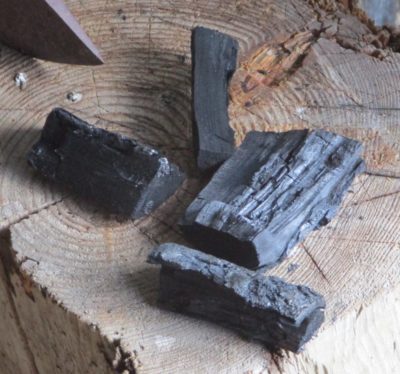


Don, I can’t see other comments but perhaps someone has already chimed in that anything zinc coated (galvanized) on high heat will offgas Zinc which is extremely toxic. I was sadly unaware of your Wuhan Flu episode and hope you will not risk endangering your lungs again with Zinc fumes!
Liked this. You might want to check out a video on making “biochar”, same as charcoal. On youtube search for “Biochar workshop part 1” or “Living Web farms biochar.” The farm makes it on industrial scale, but this workshop shows how to use a trashcan inside a drum, the combustible gases from the wood inside the trash can serve as fuel for the outer fire, so they are more efficiently burned to make the charcoal. This looks like it would suit your scale and might maximize efficiency/reduce smoke production. Happy grilling!
Hi Don,
Your post reminded me if this video. These guys are great.
https://m.youtube.com/watch?v=FqRCnF9dovw
Also, my wife was born in Thailand and she told me her grandmother used to make charcoal in pit. Ill try to get full details but your way looks much more efficient.